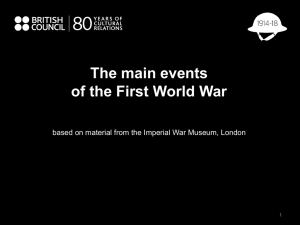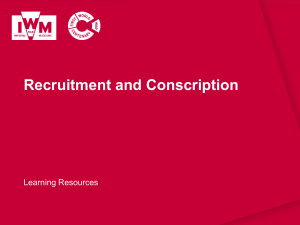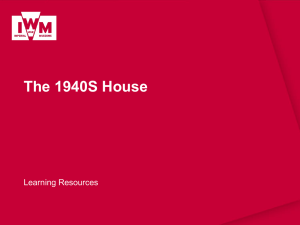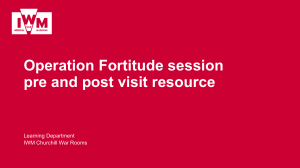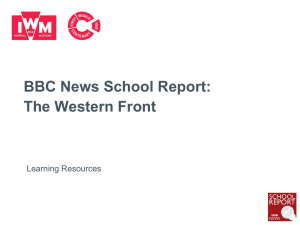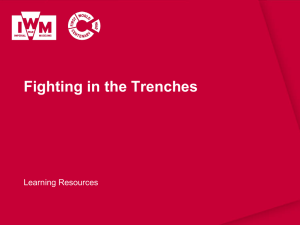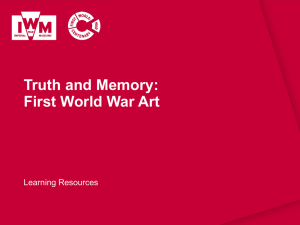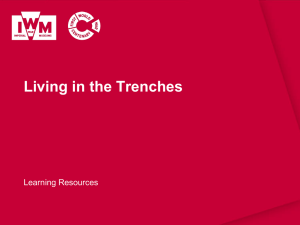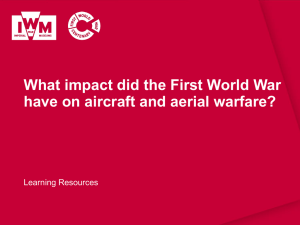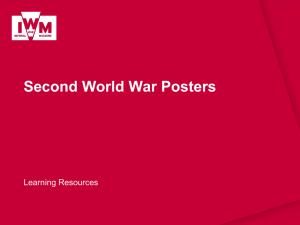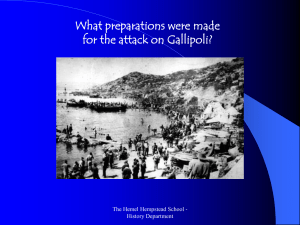The Gallipoli Campaign
advertisement
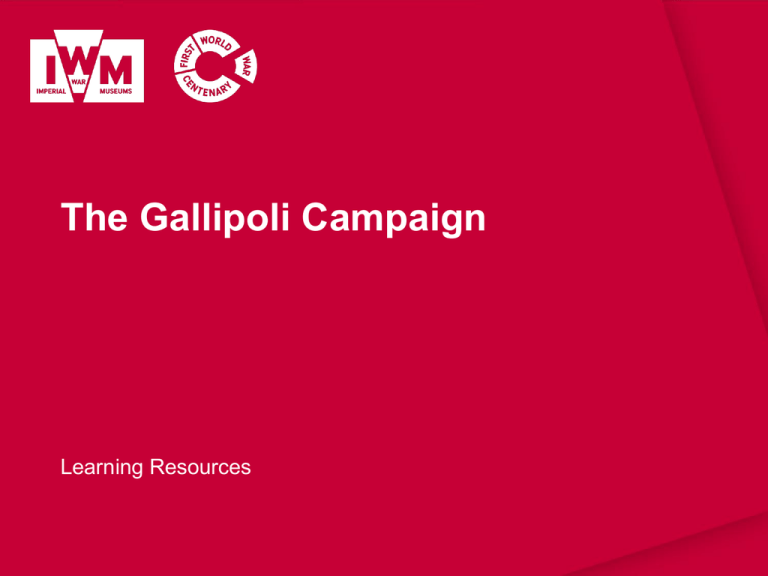
The Gallipoli Campaign Learning Resources IWM Learning Resources: Terms of Use • The images in this resource can be freely used for non-commercial use in your classroom subject to the terms of the IWM’s Non Commercial Licence: http://www.iwm.org.uk/corporate/privacy-copyright/licence • You can use the full presentation or use individual slides within other presentations for use within school and to share with other teachers for their non commercial use as well. • You can print the images out up to A4 size if you wish to use hard copies with your class. • Each image comes with an attribution statement, which must be included wherever the image is used. For example, © IWM (Art.IWM ART 1179). • Every effort has been made to contact all copyright holders. IWM will be glad to make good any error or omissions brought to their attention. • By downloading this PowerPoint and using these images you agree to these terms of use, including your use of the attribution statement specified for each object by IWM. © IWM (EPH 951) A map of the Dardanelles Peninsula By 1915, neither the Allied Forces nor Central Powers were making much progress on the Western Front, so new options were considered to turn the tide of the war. The Allied Forces believed that capturing Constantinople, the capital of the Ottoman Empire, would weaken the Central Powers. However, the success of the Dardanelles campaign depended on the quick defeat of the Ottoman Turks. © IWM (Art.IWM ART 249) Naval Offensives Throughout February and March the British and French navies bombarded coastal forts and artillery positions along the Dardanelles Straits, hoping to force their way through to Constantinople. There was some early success but the last attempt on 18 March ended in complete disaster with five warships sunk or disabled. Allied commanders decided that troops would need to land along the Gallipoli peninsula to conquer the Turkish defences before the naval attacks could resume. © IWM (Q 112876) Landings at Anzac Cove at 8am, 25 April 1915 On 25 April 1915 Allied troops landed on a series of beaches along the Gallipoli peninsula. The Turkish defences were well prepared and Allied troops struggled to get ashore as the Turks contained the landings. Both sides suffered devastating losses. In this photograph Sapper R Reynolds lies at the waters edge, an Australian engineer, and the first to fall during the campaign. © IWM (Documents.9576) Letter from Sergeant G. Keen This letter from Sergeant G. Keen contains a description of the Gallipoli landings and the bitter fighting during the first days of the campaign. © IWM (Q 13447) Trench Warfare After the landings, trench lines were quickly established. They became more extensive but, remained much the same for the rest of the campaign. Life within the trenches was hard and conditions were poor. In this photograph a Royal Irish Fusilier attempts to draw the fire of a Turkish sniper to reveal his position. © IWM (Q 13392) Turkish Snipers Due to the nature of the terrain and hills that surrounded the Allied trenches, Turkish snipers were a continuous threat watching over the Allied positions. This led to many deaths and an almost constant state of fear. This photograph shows a Turkish sniper immediately after capture. © IWM (Art.IWM PST 0398) Australian Enlistment poster The land campaign in Gallipoli meant that the Allies’ already limited resources were stretched even further. They now needed to send thousands of men along with supplies such as food, weapons and munitions to a new front. In 1915 Gallipoli was the only campaign that soldiers from the Australia and New Zealand Army Corps (ANZAC) were involved with. It became a focus for recruitment in those countries and has remained one of the most defining and unifying moments in Australia and New Zealand’s history. © IWM (Q 13622) ‘Mateship’ A legacy of ‘mateship’ was cemented in the Australian and New Zealand ranks during the Gallipoli campaign. This characterised ANZAC soldiers as tough, resourceful men, loyal to their mates and their country. They were seen as courageous in battle and having a healthy disdain for any authority. This photograph shows an Australian carrying a wounded comrade on his shoulders on Walkers Ridge down to a medical aid post. © IWM (Q 13372) Who fought at Gallipoli? Troops from all over the world fought at Gallipoli. The British army included men from Britain, Ireland, Australia, New Zealand, India and Newfoundland (now part of Canada). The French army included men from many of their North African colonies as well as France itself. This photograph shows troops of the 14th Sikhs of the 29th Indian Infantry Brigade examining a piece of shell from "Asiatic Annie“, a notorious Turkish gun that constantly shelled the Allied forces at Helles. © IWM (EPH 9022) General Hamilton’s Fly whisk The conditions at Gallipoli were some of the worst of the whole war, the extreme weather caused widespread sickness and sometimes death. Swarms of flies were a constant presence in the trenches, mainly due to the many dead left in no-man’s land. The fly whisk, pictured above, was carried by General Sir Ian Hamilton, Commander-in-Chief of the Mediterranean Expeditionary Force at Gallipoli, 1915. He wrote, ‘At the Dardanelles it was always in my hand…’ © IWM (Q 13644) Extreme weather and disease Scorching heat during summer gave way to torrential autumn rain and a freezing winter. Almost all soldiers suffered from dysentery. This photograph shows frost-bitten soldiers lying on straw in shelters constructed of biscuit boxes, after a blizzard in November 1915 that caused some 160,000 cases of frostbite, and froze 280 men to death. © IWM (Q 13448) Water shortage and rationing (Audio File) During the blistering summer months clean water became a limited resource and had to be strictly rationed. This photograph shows men preparing water rations. © IWM (Art.IWM ART 2452) Troops Landing on C Beach, Suvla Bay, later in the day, 7th August 1915 by Norman Wilkinson In August 1915 new offensives and landings were launched along the peninsula to try and break the stalemate, including the one shown in this painting. Fresh troops were brought in finally to try to defeat the Turks, but these offensives only resulted in even more devastating losses and the deadlock returned. Eventually the decision was taken that an evacuation of all troops had to be made. © IWM (Documents.10220) Evacuation Plans for the evacuation of the peninsula were carefully drawn up and included many elaborate tricks to ensure the Turkish did not realise what was happening. They were designed to keep deaths to a minimum and there were only three reported casualties from the evacuation. Supplies were destroyed as they went to ensure that they did not fall into enemy hands. Half of the forces were evacuated from the peninsula in December and the last men left on 9 January 1916. © IWM (Q 13438) Devastating loss of life For a campaign that lasted less than a year the death toll at Gallipoli was very high. Approximately 44,000 British, French, ANZAC and Indian troops were killed. Coming so early in the war, this huge loss of life had a powerful impact on those at home particularly in Australia and New Zealand as this was the first time they had suffered such heavy losses. Estimates of those killed from the Ottoman Empire range between 66,000 and 86,000. The Gallipoli Campaign Learning Resources
